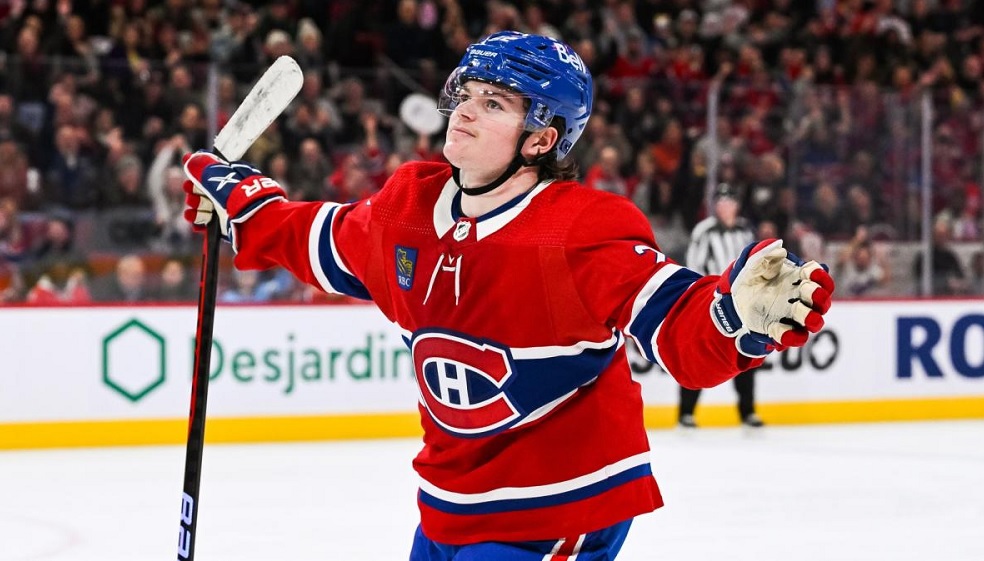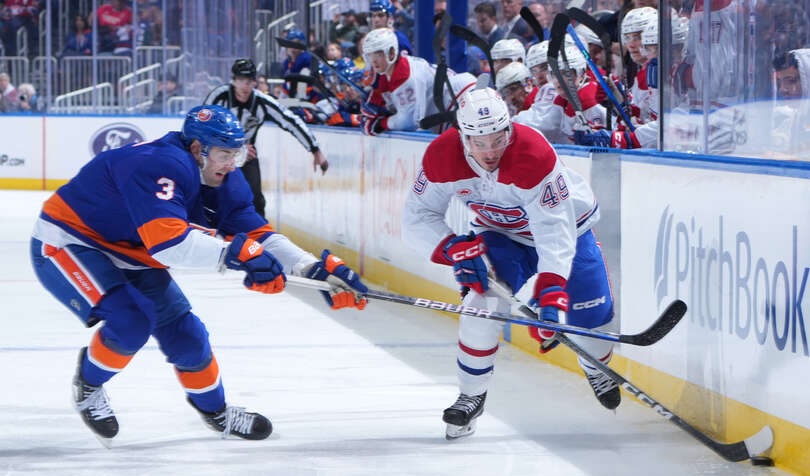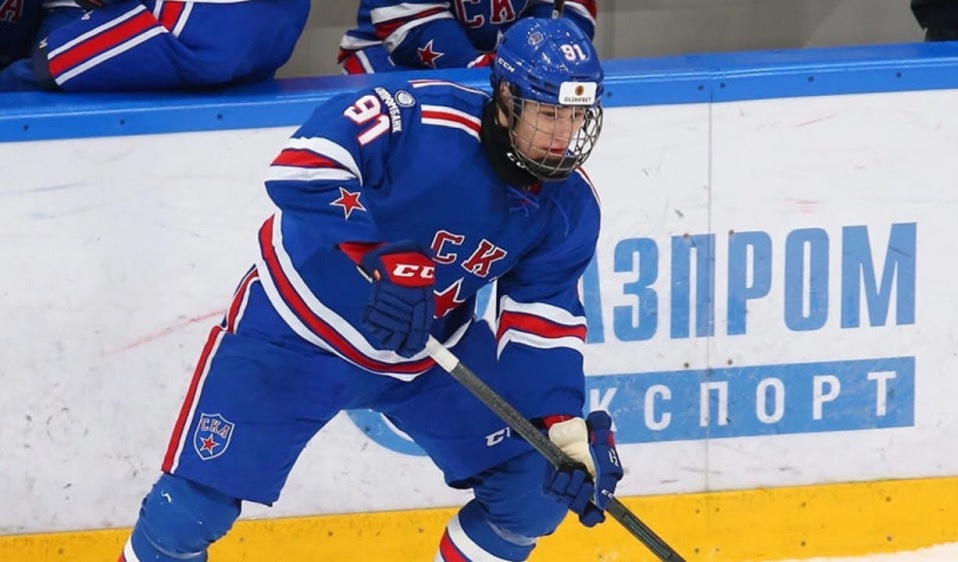HabsWorld.net --
The Canadiens took care of their most prominent pending restricted free agent on Monday, signing Cole Caufield to an eight-year, $62.8M contract. Our writers offer up their mixed opinions on the move.
Terry Costaris: I love Caufield as a person. He oozes charm. His talent is legit. He definitely has the skillset to be a premier goal scorer. But man, he’s a tiny little guy for the NHL.
I realize other small players have had long careers but man, he’s a tiny little guy for the NHL.
There are so many what-ifs here. What if he gets seriously injured? I guess there’s LTIR.
What if he stays healthy, and all goes to plan? Montreal has snagged itself a great bargain particularly if the cap goes as high as expected. However, black swan events do happen. Teams such as the Toronto Maple Leafs learned this lesson the hard way, thanks to COVID.
If my memory serves me well, Ken Dryden, either in his book Home Game or in an article that he wrote, discussed the physics of hard checks. In it, Dryden clearly explained the formula that we were taught in high school: Force = Mass x Acceleration from a hockey context. Basically, he said that the force of an impact, its intensity, is equal to how beefy a player is times his speed.
So, one 220-pound player going at 40 km/h can do a lot of damage on someone much lighter than him.
Little Caufield has already had shoulder surgery. Is it unreasonable to expect that there’s more injuries to come?
At the very least, Montreal has to tap out on drafting or signing any more small skilled players if it hopes to win a Stanley Cup.
Hockey is like a very expensive demolition derby with some Cole Caufield Lamborghinis in it. Hopefully, Caufield will be as durable as Yvon Cournoyer, Mats Naslund, Brian Gionta, and his coach, Martin St. Louis.
It’s possible, but Force = Mass x Acceleration.
Allan Katz: As the weeks slid by, I had feared that Caufield’s agent was asking for the moon. My concern was a repetition of the Maple Leafs’ multiple 10 million+ dollar players clogging up the cap room. A long-term deal in the Suzuki range would mean that in the next few years, there will be cap room for depth acquisitions so necessary to build long-term success. Hockey is a team game and this contract contributes to the team’s future as much as it does to Caufield’s wallet. Both players will be slightly overpaid to start their deals and should be underpaid near the end of their deals provided their expected trajectories work out according to plan. The gamble is Suzuki develops into an 82-point-a-year player and Caufield develops into a perennial forty-goal scorer.
It would seem that injuries would be one of the few reasons this would not work out. There is also a possibility that Suzuki peaks in the 90+ point range and Caufield hits 50 a few times. This deal is a home run for the Habs and guarantees enough money to keep Caufield’s grandchildren in high-quality hockey gear.
Brian La Rose: This is certainly a contract that carries some risk for Montreal. If he doesn’t come back fine from the shoulder injury, if he goes back to being the player he was early in 2021-22, if he winds up being injury prone due to his size, this could backfire in a big way.
However, it can also pan out in a big way. If Caufield does become a consistent 40-50-goal threat, his market value after a possible bridge contract could have approached the $10 million mark in a higher cap environment, should it go up as high as some seem to think it will. If he and Suzuki wind up on below-market contracts a few years from now, those ‘savings’ can be put toward adding another player or potentially keeping another core one in the system which can be a real difference-maker in the standings.
It’s definitely a gamble on the part of the Canadiens who are banking on Caufield showing that he has another gear or two in him and can stay healthy over a full season. If he’s able to live up to that, this deal will work out quite well for the Habs. If he doesn’t, it could be problematic down the road.
Kevin Leveille: Both the money and term on the Caufield extension are market value for today’s flat-cap NHL reality. So, to all the Habs fans on Twitter claiming that this was a steal by Hughes, I believe you are incorrect, for now.
The risks for the Habs with this contract are minimal. Caufield had played in over 70 games the season before this one that was marked with a shoulder injury. His size will mean he might be more injury prone later in his career, but this early should not be such a factor.
The rewards here are many. The Habs have clearly established a contract hierarchy structure similar to those in Boston and Pittsburgh previously. They ensure a solid base that they can build around in locking both Caufield and Suzuki together for the next seven seasons. While some will argue that both Caufield and Suzuki would be better suited for second-line duty, I will argue that they are two players who need to be better surrounded before we can make that call and that they are both players that have already proven they will elevate when the games matter.
Finally, consider the expected important rise in the cap for years to come and it’s reasonable to believe that this contract for Caufield will come in at a steal of a percentage against the cap before it is expired. Smart by Cole to secure his paycheque moving forward. Smart by Hughes to secure a cost in a player who could have potentially cashed in huge in a few years under a bigger cap if his production continues as is under coach St. Louis. Great signing here!
Peter Longo: I’m calling Caufield’s new contract the All Risk/No Upside contract. In fact, Caufield’s agent absolutely owned Hughes and mopped the floor with him. Somehow despite a career-high of just 26 goals, Caufield etches out the second-biggest forward contract in Habs history.
Realistically, the Habs are paying Caufield as if he’s scored 40-50 goals consistently. And if he had done that, I’d be fully on board with the contract or even a larger one. But let’s face it – Caufield’s first season was disastrous as he scored only one goal in the first 30 games and was rightfully sent down to the AHL. Following his return, he did play better and ended up with 23 goals and 43 points over 67 games. I’m no fan of Dominique Ducharme but you can’t blame him for all the troubles – certainly not that vast a difference in performance.
In his 46-game second season, Caufield played better – scoring 26 goals in 46 games until a shoulder injury ended his year. But that’s it. Don’t get me wrong, both these seasons are fine and Caufield showed good growth and still lots of potential, but the inconsistency is extremely troubling.
The Habs have signed an eight-year, $7.85M AAV contract with a player who has never played a full season in the NHL and has never scored more than 26 goals or 43 points. To say this is high risk is an understatement. There’s no denying his potential but will Caufield score 50 goals next year? Or will he be sent down to the AHL again? Or will he be someone like Jonathan Drouin who oozes potential but can’t seem to put it together? Nobody knows – not even Hughes – so to make a signing like this is a huge gamble.
Ok, so accepting that the Habs took on a lot of risk, is there any upside to balance that out? Could Caufield play above the $7.8M5 level and dominate by scoring over 60 goals consistently (like Alexander Ovechkin)? So perhaps he can dominate with speed (like McDavid) or skill (like Kane)? All highly unlikely to be polite. So there’s just no upside for the Habs. The best they can do is break even with a fair deal if Caufield can produce in the 40-50 range consistently.
So, I’m struggling to understand how Hughes was outmaneuvered. Caufield was coming off a Jekyll and Hyde performance in his rookie contract and had no arbitration rights so he seemingly didn’t have much negotiating power. Could another team have offered him a contract? Sure – but if you are willing to pay the $7.85M now, there’s nothing to fear. If another team offers something in that neighbourhood – you match it – like Carolina did with Sebastian Aho. That certainly seems to have worked out well for them. It’s hard to imagine another team would have offered more than $7.85M so I don’t think an offer sheet was any real danger.
Hughes should have used his leverage and followed what Steve Yzerman did with Nikita Kucherov. After scoring 65 and 66 points in back-to-back seasons to end his rookie contract in 2015-2016, Yzerman signed Kucherov to a three-year bridge contract at $4.7M per year. And that’s after two trips deep into the playoffs with Kucherov (the Stanley Cup Final in 2015 and Conference Final in 2016). And when Kucherov showed he was over a point-per-game player and excellent in the playoffs, Tampa signed the big eight-year, $9.5M contract. But Tampa knew exactly the type of player they were getting and they were happy to make that signing. If on a bridge contract Caufield scores 40-50 goals, then you are happy to pay him (even more if required) but at least you know what you are getting. And with the success that Tampa has had, it’s a pretty good roadmap to follow.
Instead, Hughes made the same mistake Kyle Dubas did in Toronto – who paid Mitch Marner, Auston Matthews, and William Nylander top dollar as if they had made some sort of accomplishment. Instead, those contracts handcuffed the team for years and those players have never demonstrated anything close to their value when it matters the most.
At this point, I’m calling this an irresponsible decision from Hughes. He may get lucky and Caufield could live up to the contract value, but that’s a big gamble with no upside. But if Caufield struggles – as he has so far in his young career – the Habs could be saddled with a terrible contract for almost a decade.
Norm Szcyrek: I think this contract is a great deal for the Habs and a good deal for Caufield. There was speculation that Caufield’s agent was trying to negotiate a shorter deal to get Cole to unrestricted free agency. It’s expected that the salary cap will increase in the next two seasons due to the CBA deal made during the pandemic to counter the sudden revenue drop. A long deal benefits the Habs.
Cole gains the long-term security which will shield him from an unexpected injury or a head coaching change. The Habs are notorious for bringing back their previous coaches, and if Dominique Ducharme were to return we all know Caufield’s production would suffer. I am not predicting that exact scenario to happen, but another like-minded coach could sour Caufield.
Dave Woodward: A long-term deal for Caufield was the right move for the Canadiens. If they opted for a bridge deal, that contract would expire at a time when the salary cap is expected to increase materially.
There is risk for the Habs. Caufield has not yet played a full season and, given his size and his recent shoulder injury, durability is a concern. However, Caufield is the most exciting young pure goal scorer to play in Montreal for a long time. And if you compare the deal’s terms to other similarly talented players around the NHL, the deal is reasonable.
While Caufield’s contract is almost the same as Suzuki’s deal, I like the fact that it’s less. Suzuki is the captain and, while he is not the pure goal scorer that Caufield is, he plays in all situations. In any event, an upper limit has been established for the RFAs, at least for now.
Hughes has also given notice to other young players (upcoming RFAs) in the organization that they will not get exorbitant, core four Dubas money while they are RFAs. The Caufield and Suzuki contracts are not cheap but they will not leave Hughes and Gorton hamstrung in their efforts to surround their core players with a good supporting cast. Vegas and the Maple Leafs have shown in this playoff year that a balanced, deep team is a much more formidable playoff opponent than a team with a handful of high-priced stars and an inferior supporting cast. Based on these numbers, Hughes and Gorton will retain adequate flexibility to build the rest of the team around their core players.


